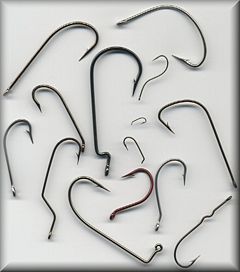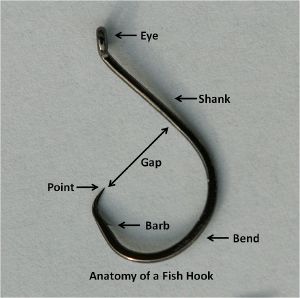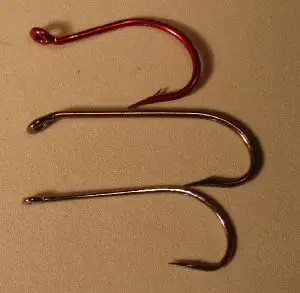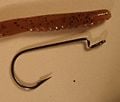Fish hook
| fishing |
|---|
| fish hooks |
| circle hook |
| hookset |
| gaff |
|
|
| tackle |
| recreational |
The fish hook is a device for catching fish either by impaling them in the mouth or, more rarely, by snagging the body of the fish. Fish hooks have been used for centuries by fisherman to catch fresh and saltwater fish. In 2005, the fish hook was chosen by Forbes as one of the top 20 tools in the history of man.[1] Fish hooks are normally attached to some form of line or lure that connects the caught fish to the fisherman. There is an enormous variety of fish hooks in the world of fishing. Sizes, designs, shapes and materials are all variable depending on the intended purpose of the fish hook.
Fish hooks are manufactured for a range of purposes from general fishing to extremely limited and specialized applications. Fish hooks are designed to hold various types of artificial, processed, dead or live bait (Bait fishing); to act as the foundation for artificial representations of fish prey (Fly fishing); or to be attached to or integrated into other devices that represent fish prey (Lure fishing).
History
The fish hook or similar device has probably been around for many thousands of years. The earliest recorded fish hooks were from Palestine about 9000 years ago. Man has crafted fish hooks from all sorts of materials including wood, animal and human bone, horn, shells, stone, bronze, iron, and present day materials. In many cases, hooks were created from multiple materials to leverage the strength and positive characteristics of each material. Norwegians as late as the 1950s still used juniper wood to craft Burbot hooks. Quality steel hooks began to make their appearance in Europe in the 1600s and hook making soon became a task for professionals.[2]
Anatomy and Construction[3], [4]
Commonly referred to parts of a fish hook are its point-the sharp end that penetrates the fish's mouth or flesh; the barb-the projection extending backwards from the point that secures the fish from unhooking, the eye-the end of the hook that is connected to the fishing line or lure, the bend and shank—that portion of the hook that connects the point and the eye, and the gap-the distance between the shank and the point. In many cases, hooks are described by using these various parts of the hook. Example: Wide gap, 2X Long Shank, Hollow Point, Turned Down Ring Eye Bait hook.
Contemporary hooks are manufactured from either high-carbon steel, steel alloyed with Vanadium or stainless steel depending on their use. Most quality fish hooks are covered with some form of corrosion resistant surface coating. Corrosion resistance is not only required when hooks are used, especially in saltwater, but while they are stored. Hooks are often coated with a clear lacquer, but you can find hooks coated in gold, nickel, Teflon, tin and different colors to attract fish. Mustad for example produces hooks in six colors including black.[5]
Hook Types
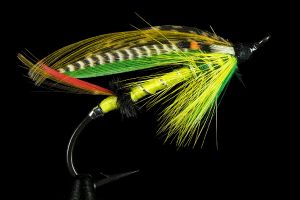
There are a large amount of different types of fish hooks. At the macro level, there are bait hooks, fly hooks and lure hooks. Within these broad categories there are wide varieties of hook types designed for different applications. Hook types differ in shape, materials, points and barbs, and eye type and ultimately in their intended application. When individual hook types are designed the specific characteristics of each of these hook components are optimized relative to the hook's intended purpose. For example, a delicate dry fly hook is made of thin wire with a tapered eye because weight is the overriding factor. Whereas Carlise or Aberdeen light wire bait hooks make use of thin wire to reduce injury to live bait but the eyes are not tapered because weight is not an issue. Many factors contribute to ultimate hook design. Corrosion resistance, weight, strength, hooking efficiency, whether it is being used for specific types of bait, on different types of lures or for different styles of flies. For each hook type, there are ranges of acceptable sizes. For all types of hooks, sizes range from 32 (the smallest) to 20/0 (the largest).
Shapes and names
Hook shapes and names are as varied as fish themselves. In some cases hooks are identified by a traditional or historic name, e.g., Aberdeen, Limerick or O'Shaughnessy. In other cases, hooks are merely identified by their general purpose or have included in their name, one or more of their physical characteristics. Some manufacturers just give their hooks model numbers and describe their general purpose and characteristics. For example:
* Eagle Claw 139 is a Snelled Baitholder, Offset, Down Eye, Two Slices, Medium Wire
* Lazer Sharp L2004EL is a Circle Sea, Wide Gap, Non-Offset, Ringed Eye, Light Wire
* Mustad Model 92155 is a Beak Baitholder hook
* Mustad Model 91715D is a O'Shaughnessy Jig Hook, 90 degree angle
* TMC Model 300 - Streamer D/E, 6XL, Heavy wire, Forged, Bronze
* TMC Model 200R - Nymph & Dry Fly Straight eye, 3XL, Standard wire, Semidropped point, Forged, Bronze
The shape of the hook shank can vary widely from merely straight to all sorts of curves, kinks, bends and offsets. These different shapes contribute in some cases to better hook penetration, better fly imitations or better bait holding ability. Many hooks intended to hold dead or artificial baits have sliced shanks which create barbs for better baiting holding ability. Jig hooks have are designed to have lead weight molded onto the hook shank. Hook descriptions may also include shank length as standard, extra long, 2XL, short, etc. and wire size such as fine wire, extra heavy, 2X heavy, etc.
Single, double and treble hooks
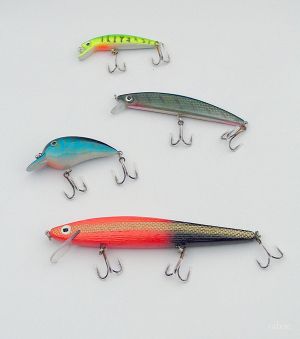
Hooks are designed as either single hooks—a single eye, shank and point; double hooks—a single eye merged with two shanks and points; or treble—a single eye merged with three shanks and three evenly spaced points. Double hooks are formed from a single piece of wire and may or may not have their shanks brazed together for strength. Treble hooks are formed by adding a single eyeless hook to a double hook and brazing all three shanks together. Double hooks are used on some artificial lures and are a traditional fly hook for Atlantic Salmon flies, but are otherwise fairly uncommon. Treble hooks are used on all sorts of artificial lures as well as for a wide variety of bait applications.
Typical bait hook shapes and names
Typical bait hook shapes and names include Salmon Egg, Beak, O'Shaughnessy, baitholder, shark, Aberdeen, Carlisle, Carp, Circle, Tuna Circle, Offset Worm and circle hook
Typical fly hook shapes and names
Typical fly hook shapes include Sproat, Sneck, Limerick, Kendal, Viking, Captain Hamilton, Barleet, Swimming Nymph, Bend Back, Model Perfect, Keel, and Kink-shank.
Points and barbs
The hook point is probably the most important part of the hook. It is the point that must penetrate fish flesh and secure the fish. The profile of the hook point and its length influence how well the point penetrates. The barb influences how far the point penetrates, how much pressure is required to penetrate and ultimately the holding power of the hook. Hook points are mechanically (ground) or chemically sharpened. Some hooks are barbless. Historically, many ancient fish hooks were barbless, but today a barbless hook is used to make hook removal and fish release less stressful on the fish. Hook points are also described relative to their offset from the hook shank. A kirbed hook point is offset to the left, a straight point has no offset and a reversed point is offset to the right.
Care needs to be taken when handling hooks as they can 'hook' the user. If a hook goes in deep enough below the barb, pulling the hook out will tear the flesh. There are two methods to remove a hook. The first is by cutting the flesh to remove it. The second is to cut the eye of the hook off and then push the remainder of the hook through the flesh.
Typical hook point types
Hook points are commonly referred to by these names: needle point, rolled-in, hollow, spear, beak, mini-barb, semi-dropped and knife edge. Some hook point names are mere branding by manufacturers such as the SP point from Tiemco.
SP stands for several words like Sport Point, Super Point or Special Point. We think these new SP point, especially SP-Barbless point are representing the sport aspect of fly fishing well.[6]
Eyes
The eye of a hook, although some hooks are technically eyeless, is the point where the hook is connected to the line. Hook eye design is usually optimized for either strength, weight and/or presentation. There are different types of eyes to the hooks. Typical eye types include the ring or ball eye, a brazed eye-the eye is fully closed, a tapered eye to reduce weight, a looped eye—traditional on Atlantic Salmon flies, needle eyes, and spade end—no eye at all, but a flattened area to allow secure snelling of the leader to the hook. Hook eyes can also be positioned one of three ways on the shank—up turned, down turned or straight.
Size
Hook sizes are generally referred to by a number. Currently Mustad manufacturers the smallest (size 32) and largest (size 19/0) hooks. The numbers do not represent any specific measurement of a part or portion of the hook, but they do represent a relative size. For hook sizes from 32 to 1, the larger the number, the smaller the hook. For hook sizes from 1/0 (one aught) to 19/0, the larger the number, the larger the hook. There is no internationally recognized standards' body for hooks and thus size is somewhat inconsistent between manufacturers. However, within a manufacturer's range of hooks, hook sizes are consistent.
Fish Hook Gallery
Hook Manufacturers
| Manufacturer | Location | Brand Names | Types |
|---|---|---|---|
| O. Mustad and Son, A.O | Norway | Mustad | All types of freshwater, saltwater, sport and commercial hooks |
| Tiemco, Inc. | Japan | TMC | Fly hooks |
| Gamakatsu | Japan | Gamakatsu | All types of freshwater, saltwater, sport and commercial hooks |
| Wright and McGill Co. | United States | Eagle Claw, Lazer | Freshwater, Saltwater sport and commercial hooks |
| Anglers Sport Group | United States | Daiichi, Tru-Turn, Xpoint | Fly hooks, Sport fishing hooks |
| Owner American Corporation | United States | Owner, | Freshwater, Saltwater sport and commercial hooks |
| Rapala VMC | Finland | VMC | Lure and Live bait hooks, treble hooks |
| Partridge of Redditch | England (Owned by O. Mustad and Son) | Partridge | Freshwater, Saltwater sport and commercial hooks |
See also
- Fishing
- Fishing boat
- Fishing line
- Fishing lure
- Fishing reel
- Fishing rod
- Fly fishing
Notes
- ↑ David M. Ewalt. No. 19: The Fish Hook, The 20 Most Important Tools, Forbes.com 08.05.05.
- ↑ O. Mustad & Son A.S.Hook History, musad. Retrieved June 21, 2008.
- ↑ Tiemco Fly Hook Catalog 2002, Teimco. Retrieved June 21, 2008.
- ↑ Mustad Hook Catalog, O. Mustad & Sons A.O. Retrieved June 21, 2008.
- ↑ Mustad & Son Wire & Hook, Hook Anatomy, Retrieved June 21, 2008.
- ↑ SP Point (SPS, SPR, SPS-Barbless, SPR-Barbless), TMC Fly Hooks, TMC. Retrieved June 21, 2008.
ReferencesISBN links support NWE through referral fees
Books and journals:
- Brandt, Andres von. Fish Catching Methods of the World. London: Fishing News, 1972. ISBN 0852380267
- Dalrymple, Byron W. How to Rig and Fish Natural Baits. New York: Outdoor Life: [distributed by] Funk & Wagnalls, 1976. ISBN 0308102894
- Dunaway, Vic. Vic Dunaway's Complete Book of Baits, Rigs, and Tackle: Freshwater/Saltwater. Miami, Fl: Wickstrom Publishers, 1995 (original 1989). ISBN 0936240121
- Mayes, Jim. How to Make and Repair Your Own Fishing Tackle: An Illustrated Step-by-Step Guide for the Fisherman and Hobbyist. New York: Dodd, Mead, 1986. ISBN 0396085555
- Mussen, William A. Fishing Tackle Source Directory. Jefferson, NC: McFarland, 1998. ISBN 0786405374
- Wakeford, Jacqueline. Flytying: Tools and Materials. New York, NY: Lyons & Burford, 1992. ISBN 1558211837
Online sources:
- Ewalt, David M.. No. 19: The Fish Hook, The 20 Most Important Tools, Forbes.com 08.05.05.
External links
All links retrieved April 11, 2017.
- Roman Scharabun. Fly Hook Comparison Chart, GFF.
- Ron Brooks. The Right Hook, About.com.
| ||||||||||||||||||||||||||||||||||||||||||||||||||||||||
Credits
New World Encyclopedia writers and editors rewrote and completed the Wikipedia article in accordance with New World Encyclopedia standards. This article abides by terms of the Creative Commons CC-by-sa 3.0 License (CC-by-sa), which may be used and disseminated with proper attribution. Credit is due under the terms of this license that can reference both the New World Encyclopedia contributors and the selfless volunteer contributors of the Wikimedia Foundation. To cite this article click here for a list of acceptable citing formats.The history of earlier contributions by wikipedians is accessible to researchers here:
The history of this article since it was imported to New World Encyclopedia:
Note: Some restrictions may apply to use of individual images which are separately licensed.

